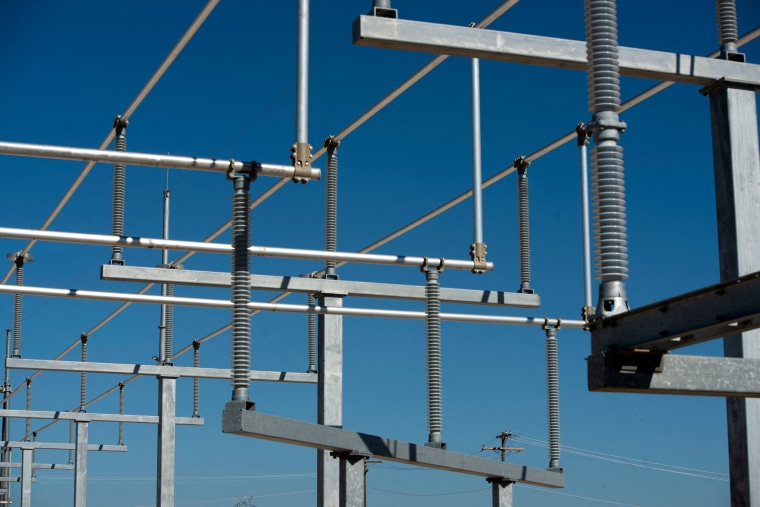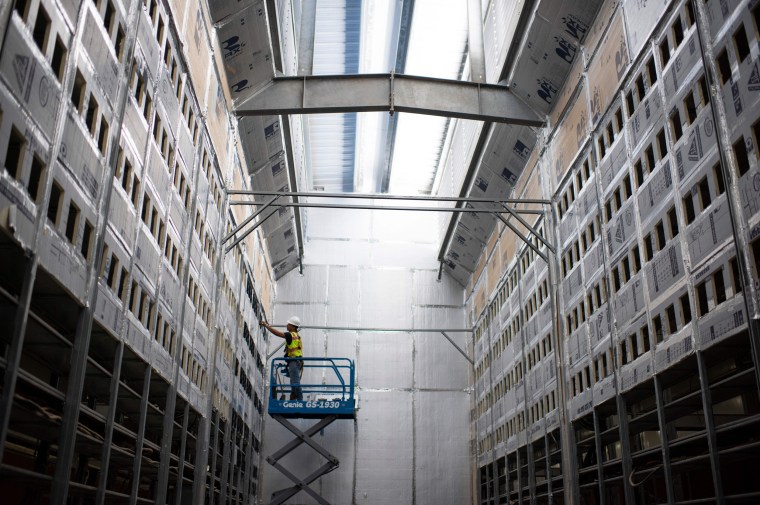Record-breaking heat across Texas has pushed its fragile power grid to the brink. But extreme temperatures are doing something else in the famously pro-business state: stirring opposition to energy-guzzling crypto miners who’ve flocked there seeking low-cost energy and a deregulatory stance.
Ten industrial-scale crypto miners now draw from the Texas power grid, according to its overseer, the Electric Reliability Council of Texas. ERCOT, as it is known, declined to say how much power the miners currently consume, but Trudi Webster, a spokesperson for the council, said miners’ consumption is anticipated to be 18 gigawatts in coming years. Current grid capacity is around 80 gigawatts, but it too is expected to grow.
Bitcoin miners deploy thousands of high-powered computers to solve complex mathematical equations; when they succeed, the miners earn a bitcoin. Annual electricity use attributed to bitcoin mining roughly equals the consumption of Belgium, according to the University of Cambridge Bitcoin Electricity Consumption Index.
Since China shut down cryptomining, the U.S. in general, and Texas in particular, have become venues of choice for the industry. Lee Bratcher, founder of the Texas Blockchain Council, a lobbying group, estimated that there are now 40 cryptomining companies operating in the state, including the 10 large ones, double the number just two years ago.
The energy crypto miners use puts “an almost unprecedented burden” on the Texas grid, according to Ben Hertz-Shargel, global head of Grid Edge, a unit of Wood Mackenzie, an energy consulting firm. Mining “pushes the system closer to dangerous system peaks at all times,” he told NBC News. “It is completely inessential and consuming physical resources, time and money that should be going to decarbonize and strengthen the grid.”
The Texas grid has come under pressure before. During winter storm Uri in February 2021, for example, demand for power exceeded supply; over 200 people died, most from hypothermia. Unlike other electricity systems, the Texas grid does not connect to other states’ grids; that means it cannot receive power from other areas in emergencies.
Because of their high demand for electricity, crypto miners raise costs for other consumers of power, Hertz-Shargel said. And, on the Texas grid, miners can get paid for powering down during peak demand periods, like the one that recently hit the state. Miners and other industrial customers with these types of arrangements receive revenues for not using electricity; the costs of those revenues are passed on to other electricity customers.

Texas electricity rates are lower than many other states’, a big lure for crypto miners. According to the U.S. Energy Information Administration, Texas customers paid on average 8.36 cents per kilowatt hour in 2020 versus the nationwide average of 10.59 cents. Prices have gone up significantly in recent months everywhere.
But the Texas grid maintains relatively few excess reserves, experts say. Earlier this month, amid the heat wave, ERCOT asked customers to restrict usage, and the miners powered down. ERCOT said in a news release that it issues such notifications “when projected reserves may fall below 2300 MW [megawatts] for 30 minutes or more.”
ERCOT, a nonprofit corporation that answers to the Public Utility Commission of Texas and the state legislature, has changed its operations since Uri, trying to make the unregulated Texas grid more reliable. But the bitcoin miners drawn to the state by low power costs and deregulation have added significant demand for power.
Bratcher and the crypto miners he represents say they provide three benefits to Texas. Because they can turn off their electricity use during high-demand periods, they can help stabilize the grid and rein in runaway power prices. “Power pricing is set off at peaks and the miners are specifically trying to turn off during peaks,” he said. In addition, crypto miners’ 24/7 demand for electricity can provide an incentive for wind and solar developers to bring more green power to the grid while new jobs and tax revenues “lead to orders of magnitude of human flourishing in communities where the mines set up,” Bratcher said.
Still, there are pockets of pushback. More than 800 people have signed a petition against a new bitcoin mining facility to be built near Corsicana, Texas, by Riot Blockchain Inc., citing higher electricity and water costs associated with the plant. The operation will be the biggest bitcoin mining facility in the U.S. when completed, Riot says.

According to a May 2022 email from a local economic development official, the new Riot facility near Corsicana will consume 1.4 million gallons of water a day and 1 gigawatt of electricity. That’s enough to power 200,000 homes during periods of peak demand. The recent census shows approximately 21,000 “housing units” in Navarro County; the county’s population is around 54,000.
Jackie Sawicky, a small-business owner, is organizing the opposition to the Riot facility. “There are over 7,000 people in poverty and 8,000 seniors living on fixed incomes here,” she told NBC News. “We cannot afford increased water costs and electricity.”
Changing lives in rural Texas
Chad Everett Harris is Riot’s chief commercial officer, and in an interview with NBC News, Harris said the company’s other operation in Rockdale, Texas, has benefited its community.
According to a 2020 economic impact report commissioned by the Rockdale Municipal Development District, an entity run by area businesspeople, the facility will deliver an estimated $28.5 million in economic benefits to the community over 10 years. The operation employs “nearly 200 full-time benefited employees,” Riot has said.
“We are a great company with almost 500 employees that have health insurance, 401(k)s, profit-sharing,” Harris told NBC News. “Rarely do you find an organization that comes into rural Texas and changes lives.”
Harris characterized Sawicky and her group, Concerned Citizens of Navarro County, as “creating a false narrative on the facts” about the new Riot facility. Regarding the water usage, Harris said: “We’re not getting a deal; we’re paying the market rate. Corsicana — they have tons of water.”
But Sawicky says the environmental impact of the Corsicana facility is unknown. “Texas is so deregulated — a lot of other states would have at least mandated an environmental impact study,” she said.
Some in Congress agree that more information is needed about the environmental impact of crypto miners nationwide. In mid-July Sen. Elizabeth Warren, the Massachusetts Democrat, and five congressional colleagues wrote a letter asking the Environmental Protection Agency and the Energy Department to require crypto miners to disclose their energy use and environmental impact data.

“Cryptomining facilities’ energy consumption is causing significant increases in energy costs for many small businesses and residents,” the lawmakers wrote. “States like Texas with relatively cheap electricity costs are experiencing an influx of cryptomining companies, raising concerns about the state’s unreliable electricity market and the potential for cryptomining to add to the stress on the state’s power grid.”
In addition to the price hikes consumers face because of increased demand from bitcoin miners, another cost can arise, at least in Texas. Under the contracts some bitcoin miners have struck with ERCOT, they get paid for powering down during times of peak demand. That means they receive money from other ratepayers for not using electricity; other industrial users have such arrangements as well.
During peak periods, miners can also resell to the grid the electricity they would otherwise have used. Because their contracts can let them buy power at low cost, energy resales when demand is high can generate significant financial benefits in the form of credits against future use. Such contracts are common among industrial users of electricity.
These contracts are usually not public, however, leaving residents in the dark about their terms and how they might be affecting other ratepayers.
“The public has not been given a choice to weigh in on these contracts and the fact that during a time of great economic fragility their pocketbooks may be hit,” said Katie Paul, director at the Tech Transparency Project, a nonprofit watchdog focusing on large technology companies. It just published an in-depth report on cryptomining in Texas.
One contract has been detailed publicly in Securities and Exchange Commission filings; it was struck by publicly traded Riot Blockchain and extends until 2030. A June investor presentation from Riot said its net cost for electricity during the first quarter ending in March 2022 was 2.9 cents per kilowatt hour, much less than what residential customers pay. “That is one of the lowest power cost agreements out there for bitcoin miners,” Riot CEO Jason Les said in a recent question-and-answer session posted on YouTube. During the most recent quarter ending March 31, Riot booked $2.5 million in power sales back to the grid, its regulatory filings show.

In peak demand periods, sales of power back to the grid can be far more substantial, records show. After winter storm Uri, for example, Riot said its giant facility in Rockdale would receive credits worth $125.1 million for the energy it sold back to the grid.
Electricity customers across the state will cover those credits, said Andrew Dessler, professor of atmospheric sciences at Texas A&M University. “Ratepayers in Texas are going to be paying it off a little bit every month for decades,” Dessler said. “It angers me so much.”
As the price of bitcoin has plummeted in recent months, Riot Blockchain’s stock has declined, falling 74% since November. The company said in a recent filing that it expects to benefit from consolidation in the bitcoin mining business. Riot says its average cost of mining a bitcoin is $13,600; bitcoin is trading at around $23,000.
Still, Hertz-Shargel of Grid Edge comes back to the costs that cryptomining poses to ratepayers and the environment, including emissions. “When you have more load in the system, you have higher real-time prices for energy,” he said. “Over time, those costs get baked into the costs that ratepayers face.”
